
Ten episodes of my podcast are in the box. What are the lessons I have learned from them? In particular, what was the impact of the podcasts on my SEO?
I started podcasting as a complement to my SEO strategy. After three months and 15 episodes recorded (they are all broadcast), I draw the first conclusions. Audience, difficulties, I talk about everything without taboos, and I will read to you exclusively the evolution of the figures of frequentation of our websites. In this article, you will also find my practical advice to equip yourselves well, and you will see how I converted my office into a mini-recording studio.
Summary
- Introduction
- The impact on the SEO
- Technical aspects
- Preparing for the podcast
- Editorial line and format
- Conclusion: should you invest in podcasting?
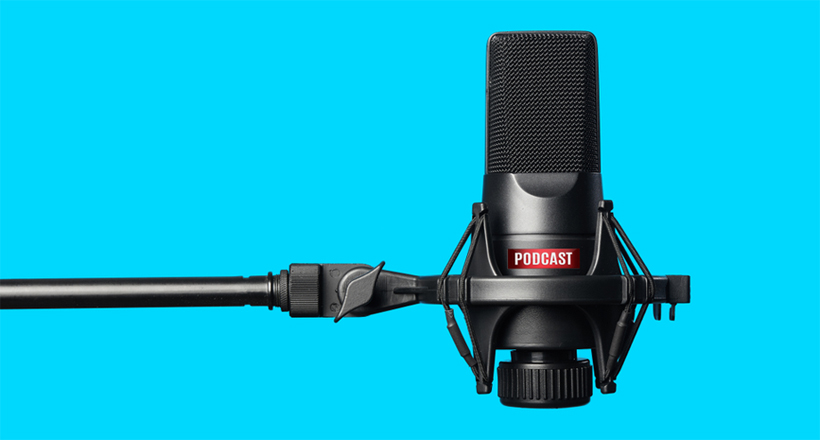
Introduction
When you start a podcast, you are often preoccupied with the technical aspects: recording material, recording formats, logically most of the articles available on podcasts are therefore aimed at discussing these aspects. I will not deviate from the rule, but I would like to point out that the technical aspects, vital as they are, should not make you forget the essential: the content and the usefulness of this format for your SEO.
I will, therefore, split this article into two:
- the technical aspects: I’m not going to dwell on this subject because there are specialists much more capable than me to talk about technique. So, I’m going to talk about what works for me and what you can copy to get a good result.
- the editorial aspects: this is essential because podcasts must be part of a more global SEO strategy.
The impact on SEO
Let’s be clear. The reason I do podcasts is, of course, to meet inspiring people and to learn more and more. But it’s also to have content that can positively influence the SEO of our website. The number of listeners of the eight podcasts I’ve published remains modest (around 500 downloads), but the impact is much more visible. Indeed, I insert the podcast into a more extensive article of about 1000 words. That talks about the company that the podcast is about (see an example here or there). I also address a more general theme: market research, finding the first customers, innovation, and so on. The podcast thus serves as a support to a broader topic that is in line with my editorial policy.
The article allows me to create content that on the one hand can be referenced, and on the other hand that will retain the reader for longer (since he listens to all or part of the podcast directly on the page). The visiting time is, therefore, positively impacted. The articles are also easily shared by the companies surveyed. They take it upon their Twitter feed, their Facebook or LinkedIn pages and some even talk about it on their website. Baptiste Derongs’ podcast is thus ranked 12th among the most consulted articles over the last 14 days.
If it’s too early to evaluate the impact on my SEO, what I can already tell you is that our traffic statistics for January 2020 have never been so good. We are breaking record after record. It is true that January also corresponds to the launch of our video series “The World of Business with Pierre-Raffaele” and that this could play a role. Would you like to see the statistics? Here they are.
The statistics of our blogs (number of single sessions, January 2020 vs. January 2019)
- In French: +17,72%
- In Dutch: +37,72%
- In English: +62,20%
Technical Aspects
I quickly realised that if I wanted to produce quality podcasts with quality guests, I had only two alternatives. Either spend my time travelling to interview them (which is expensive and not efficient) or adopt more efficient work routines that reduce costs. So, I opted for 2 straightforward solutions: the first is to bring the guests to the studio I’ve set up; the second is to make remote podcasts in conditions close to the studio.
My podcasts are published on Libsyn because this platform is the only one connected to Deezer. When you publish more than 30 minutes per month, the 250 plan at 15$/month is the best choice. The disadvantage of this type of subscription is that you can only create one show per subscription. As I intend to launch a short 3-minute format as well (I explain everything here), I’ll have to pay an extra $5 subscription.
5 golden rules for a quality recording
- Record on separate audio tracks
- Provide quality microphones
- Speak close to the microphone
- Use a Pop-filter
- Have excellent sound insulation to avoid echoes
Face-to-face Podcasts
Most of the podcasts you listen to are done face-to-face, in an improvised studio. If you want to do the same thing you can invest in a studio (are you kidding?), rent one (the podcast is going to be expensive) or create one at home with bits and pieces. That’s the option I chose, and I managed with a budget of +/-500€ and a lot of hassles to get a good result. I talk about hassles because my first three podcasts were perfect in terms of quality (see below the example of podcast n°1 with Karim Debbah, in French). Still, I couldn’t manage to reproduce this level of excellence in the following sessions (there were always some echoes). I finally found the solution by placing curtains behind the microphone (see below the pictures of my amateur studio).
Here’s the equipment I’ve invested in:
- 2 Marantz Professional MPM1000 microphones (42,50€ each)
- 2 acoustic shields on a stand (60€ / each)
- 1 zoom H6 recorder that I had already bought for the making of our videos (260€)
- 2 pop filters that also allow me to define the ideal distance to be kept with the microphone (3,65€ / piece)
- 5 hooks (5€)
- a thick curtain (hung on the hooks, see photo below).
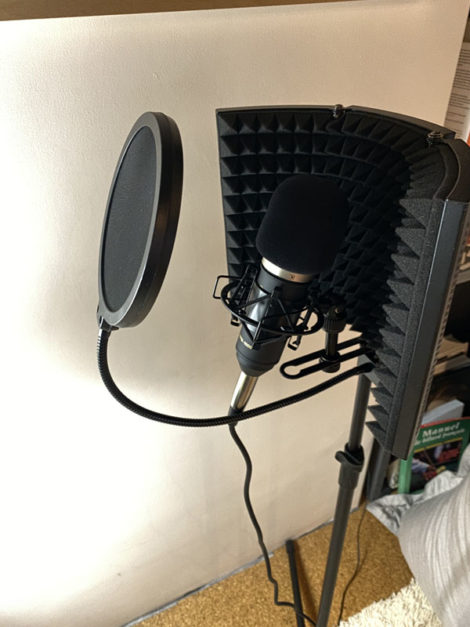 On second thought, I would have probably been wiser to buy a telescopic arm for the microphones, but in that case, I would have had to remove the acoustic screen. What is the problem with the acoustic screen’s stand? It sometimes gets in the way when guests are sitting down. To be able to approach the microphone, the body is sometimes in an awkward position, and there is always the risk of touching the stand and making some noise. It’s up to you to see what you prefer.
On second thought, I would have probably been wiser to buy a telescopic arm for the microphones, but in that case, I would have had to remove the acoustic screen. What is the problem with the acoustic screen’s stand? It sometimes gets in the way when guests are sitting down. To be able to approach the microphone, the body is sometimes in an awkward position, and there is always the risk of touching the stand and making some noise. It’s up to you to see what you prefer.
Remote podcasts
Unless you’re a very well-known media and get people moving, at first, you’re going to have to be smart to launch your podcast. In particular, if you want to have exciting guests, you’d better interview them there where they are. If you have editorial ambitions and you want high quality, it’s just unmanageable. You can’t spend your time visiting your guests with your equipment. Remote podcasting is, therefore, the solution of choice to make quality programmes and go beyond your immediate geographical horizon. So, I did a lot of research online (this article was useful) and found a system that works well for me. It’s called Cast, an online platform that records participants’ voices on separate audio tracks (like a Zoom H6 would do). However, it would be best if you had an excellent USB microphone (I chose a Rode NT-USB model for 110€) and your guests will also need an external microphone. The disadvantage of this platform: it only works with Google Chrome, and the files are only available in .mp3 format. As I know that the recording format is a subject often debated, I’ve made a small allowance (see below).
Is it necessary to register everything in .wav?
The answer is no. If the quality of the recording is terrible in .wav, it will not be possible to improve it any more than if your file is in mp3. Your priority is, therefore, to have a recording of impeccable quality. For remote recordings, I use Cast, which gives excellent results and records everything in .mp3.
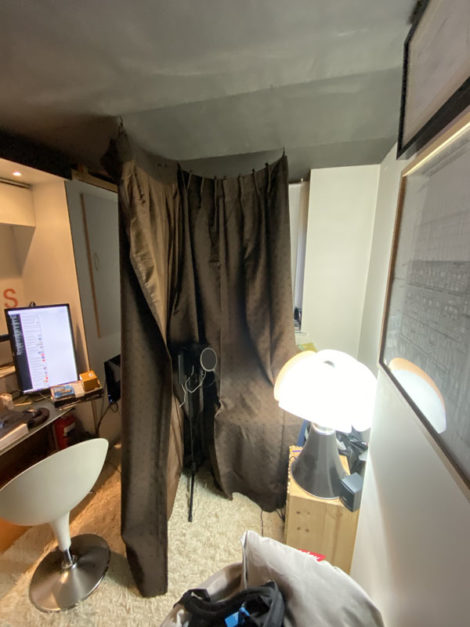 To reduce the noise in my studio office as much as possible, I fixed five hooks to the ceiling. They allow me to hang a heavy curtain (collected from my parents’ house) in front of the window. This reduces the echoes from the sound and cuts off any interference from the outside. It’s not pretty, but the result is perfect, and once the podcast is finished, you can take it all down.
To reduce the noise in my studio office as much as possible, I fixed five hooks to the ceiling. They allow me to hang a heavy curtain (collected from my parents’ house) in front of the window. This reduces the echoes from the sound and cuts off any interference from the outside. It’s not pretty, but the result is perfect, and once the podcast is finished, you can take it all down.
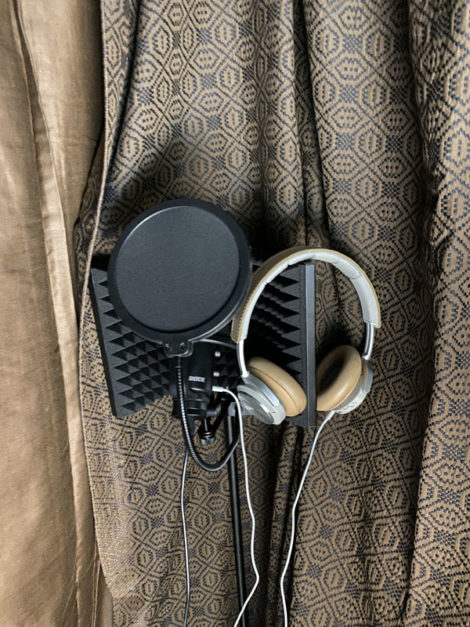 I’m still hesitant to buy soundproofing foam. The price is derisory, but the place taken once the podcast is finished is what puts me off. In any case, the curtain technique works well. Whereas on my first podcasts, one could hear the echo of the room, with the curtains, it is very well absorbed, and the quality of the sound is incomparable. The only concern is that your guests will not be in the same recording conditions and it will be heard. Seen up close it looks like this (see picture on the right).
I’m still hesitant to buy soundproofing foam. The price is derisory, but the place taken once the podcast is finished is what puts me off. In any case, the curtain technique works well. Whereas on my first podcasts, one could hear the echo of the room, with the curtains, it is very well absorbed, and the quality of the sound is incomparable. The only concern is that your guests will not be in the same recording conditions and it will be heard. Seen up close it looks like this (see picture on the right).
My home studio is improving during the Coronavirus crisis (updated 19/03/20)
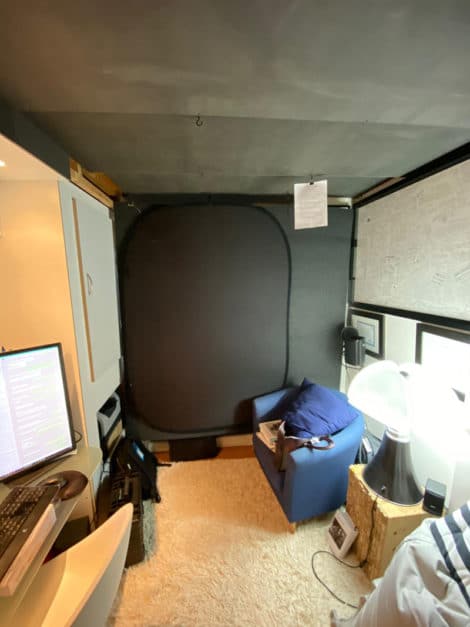 Confinement during the Coronavirus obliged, I took advantage of it to somewhat enhance the conditions of the recording of my podcasts.
Confinement during the Coronavirus obliged, I took advantage of it to somewhat enhance the conditions of the recording of my podcasts.
In the meantime, I had given in to the temptation of the soundproofing foam that I bought in 2x1m panels. With hooks fixed in the false ceiling, I was able to hang the foam-panels in front of the window and make a barrier to the noise coming from outside. It is very efficient. A further refinement, since I have to make videos from home now too, I have suspended a photo background directly on the foam panels. It’s very stable and the foam, in addition to its soundproofing function, acts as a barrier to light coming from outside.
Preparing for the podcast
I was positively surprised after my first three podcasts by the ease with which they took place. Before each podcast, I develop a ” conduct ” (like radio conduct) that I share with my guest. This conduct is a little bit the frame of the program, but I allow myself to deviate from the topics initially planned to deepen a particular aspect or challenge my guest.
If you have mastered the subject, it necessarily follows that you ask relevant questions. The answers, therefore, have an added value for the listener of the podcast. Rather than a meek conversation, consequently, I challenge my interlocutor to ask difficult questions that require going beyond the usual clichés. Most of the clichés bore me because they remain on the surface of things.
Nevertheless, my current format does not yet satisfy me, and my experience in the field now pushes me to explore alternative arrangements (this is what I explain in the following paragraph).
The six instructions that I communicate to my guests before a remote recording
- Have an external microphone available (a lapel microphone or a headset with a built-in microphone, for example). The webcam microphone is not allowed. It gives catastrophic results because it is omnidirectional.
- Make sure you have Chrome installed on your computer (Cast only works with Chrome)
- Make sure you have a good Internet connection.
- Isolate yourself in a well-soundproofed room with no echoes. Beware: any noise (door slamming, colleagues talking,) will be picked up and will affect the quality of the recording.
- Put your cell phone on aeroplane mode before you start. Make sure that in aeroplane mode the Wi-Fi is also switched off.
- Close Outlook, WhatsApp and any applications that may send notifications that may be heard during the podcast.
A stronger editorial line and more tangible added value
As exciting as podcasts can be for me, I realise that the format remains unattractive to most listeners. Who still has time to listen to a 15-minute show?
If the user is actively looking for information, my intuition tells me that I need to provide a much shorter, synthetic and even more information-concentrated format. So, I’m thinking of creating two separate lines of podcasts. The first one will be a concise format (3 min, in English) and the second one will be a longer, conversational format.
Short format
The short format is the one that I intend primarily for the synthesis of complicated subjects. In particular, I would like to create a series to popularise recent scientific studies related to marketing, entrepreneurship or Big Data. As scientific publications are mainly in English, this short format will necessarily be recorded in English as well. Given the time constraints, only three questions will be asked. If you have ideas for the name of the podcast, I’m open to suggestions.
- What was the objective of your research?
- What are the main results?
- How can they be applied in real life?
Long format
On the other hand, despite the pleasure I take in talking about marketing and entrepreneurship, my intuition also tells me that the long podcasts I make with entrepreneurs need to be much more structured. Like the written interviews I did in 2019, I will try to divide these podcasts into “chapters”. This way, I will be able to offer both the whole podcast of +/- 15 minutes in a homogeneous format between episodes, but also cut each chapter to insert them into my blog. As not everyone wants to hear the whole story, this seems appropriate to me. In this way, I will also be able to recycle my recordings more efficiently to offer them here and there in other articles. This is the principle of upcycling. Here are the chapters I have thought of:
- Chapter 1: your entrepreneurial experience in 3×3 points
- Chapter 2: the genesis of the business idea
- Chapter 3: the validation of the business idea
- Chapter 4: starting up
- Chapter 5: the take-off
- Chapter 6: the future
Conclusion: Do we need to invest in podcasting?
I was dubious about podcasting and its effects on SEO. Indeed, podcasts are not yet referenced automatically in Google. You still have to type the keywords + “podcast” for them to appear in search results (see screenshot below). But I hope that podcasts will one day be directly integrated into the first page of results, as videos are today. On that day, my efforts will pay off because I will have been the first in my field to invest in this format.
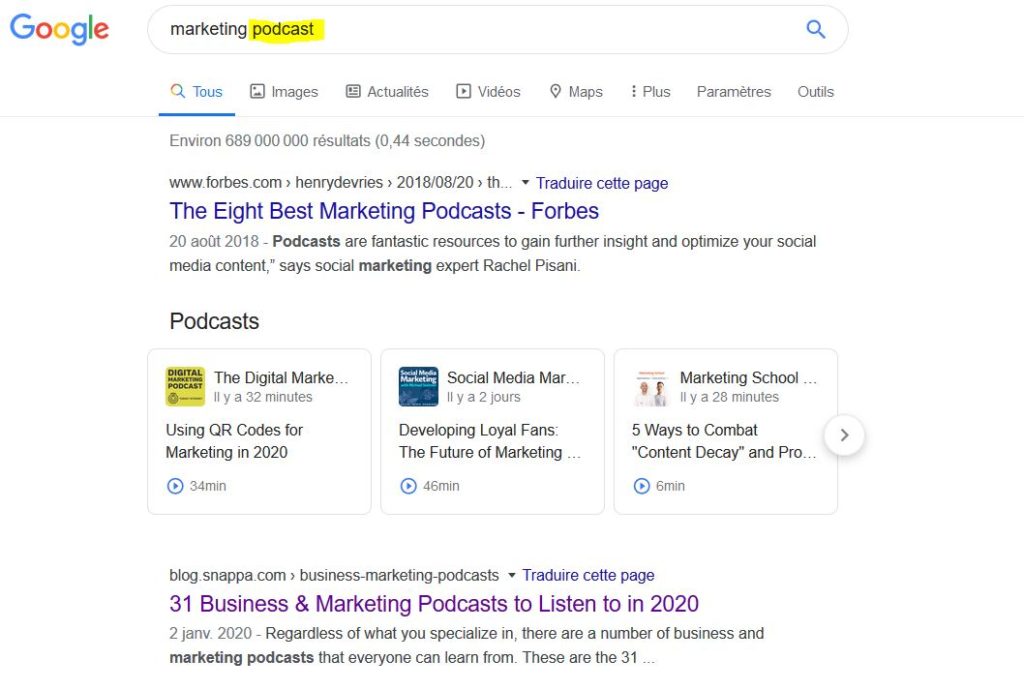
But even without it, I’m quite satisfied after only ten episodes produced. Our audience statistics are exceptional; our SEO has never been better. But honestly, it’s not the 500 downloads of the eight podcasts published that have anything to do with it. I instead think it’s the articles, created around the podcasts, and their propagation on social networks that allow us to attract a new audience. In the end, and as always, it is the content that is key to creating and retaining an audience. And that’s precisely what I’m doing: trying to create original, useful and quality content around marketing and entrepreneurship. If you are interested in podcasting and would like some advice, don’t hesitate to contact me.
Illustration images: shutterstock
Posted in Marketing.


